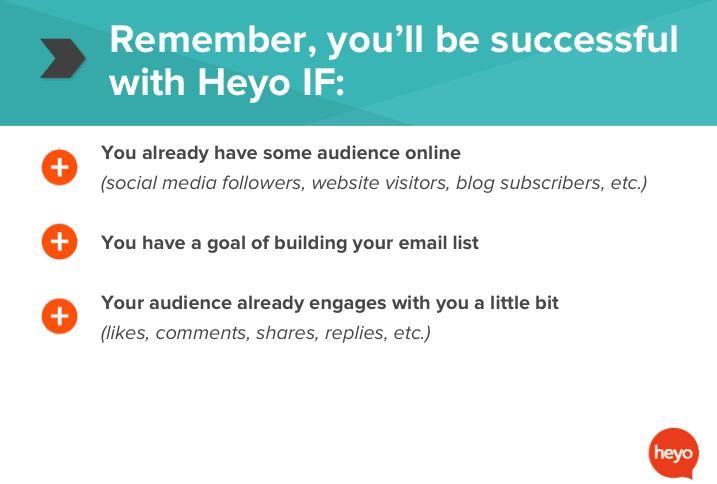
I spent much of the last two years running business operations at Heyo, a social media campaign platform for small businesses.
At its core Heyo is a tool for gathering leads by getting people to opt in and provide you with contact information. One of my responsibilities there was to keep our sales funnel strong, and a big part of that was making sure that customers were having success with our product.
At one point we were seeing many customers sign up, pay for a plan, and then leave unhappy because they weren’t having success. (Mind you, it wasn’t “most” customers, but a high enough percentage that I wasn’t happy about it.) Normally, if I were working on a product that had unhappy customers, I’d assume it was time to pivot. However, we were also seeing tons of customers happily use Heyo to build their email list, so I knew it had to be something else.
I didn’t know exactly what was going on, but based on my experience with the product I did have a hypothesis.
I believed that we had a certain percentage of new signups who were excited enough about getting new leads that they signed up, but didn’t have a significant enough audience online (social media followers, blog readers, website visitors, etc.) to truly have success with our product.

I decided to pick up the phone and call every customer who had signed up for a paid plan over the last thirty days. My goal was to figure out whether or not they had a significant enough audience to actually generate new leads with Heyo.
At the time, we saw most Heyo customers driving leads from within their Facebook fan base. My assumption was that the larger and more engaged the new customer’s audience was on Facebook, the more likely they were to have success, so I needed to uncover two specific data points from each customer call.
- How many Facebook fans (or other audience) did they have?
- How engaged was their fanbase/audience?
At the time I sat next to a whiteboard wall, so I drew a huge graph on the wall with the x-axis charting audience engagement and the y-axis charting number of Facebook fans. In order to test my hypothesis, I decided to plot every new paying customer on that graph to get a sense of exactly who was signing up for our product.
The graph looked like this:

Note: Without a hard number I could apply to gauge audience engagement, I used a subjective, one to 10 scale (and my best judgement). It wasn’t perfect, but it worked.
It only took plotting about 15 or so calls to see what was going on. While we had many customers signing up who had a substantial audience and really good engagement, we also had a lot of folks signing up who just weren’t ready to run a contest yet.
They might have been a new startup with no presence at all, or even a more established business that just didn’t have any organic audience online.
By the time I was done, here is what the graph looked like:

We had a material population of new customers signing up that really had no business doing so…yet. After some further research it became clear that this same population of folks were also the ones struggling to have success with our product.
And this was the moment that you all knew was coming, right? The moment that I decided we had to start firing our customers… for their own good.
My goals were as follows:
- Steer customers away from signing up if they had a very small or very unengaged audience.
- Invest more time helping customers with a material audience to have success.
I believed that if we could accomplish these two goals we’d be doing right by our customers and our business would benefit as an outcome.
How to fire your SaaS customers
For a customer to be successful with our product, they needed to have at least 500 fans on Facebook or an equivalent audience somewhere else (website, email, blog, Twitter, etc.).
We also needed to see that the audience cared about and engaged with them (likes, comments, shares, replies, retweets, etc.). I made the following chart and shared it with every member of the team.

Our new goal was simple – only take on new customers who were outside the trouble zone. If a prospective customer didn’t have the ingredients for success, then we should talk them out of using Heyo and lovingly encourage them to build their audience before coming back to try again, as well as provide some recommendations on how to do so.
The results
With our plan to fire customers in place the team went into action. Here are some practical examples of what that looked like for different areas of our business.
Sales demos
At the time we were offering personal demos of Heyo.
Every time we gave a demo to someone who clearly did not have much of an audience online, we’d say something like this: “Denise, Heyo is a great tool for converting traffic into new leads, but you really need to have an audience first. I’d recommend that you don’t sign up for Heyo right now. Instead, you should focus on building your audience online, and then come back to us when you are ready.” Prospective customers who heard this we floored… in a good way. They felt like we really had their best interest at heart.
Customer care
Our customer care team received a system-generated email every time someone on a free trial published a new campaign. The team would simply view the customer’s online profile (website, social accounts, etc.) and then determine whether or not that free trialer was a “fit” or not. If not, they’d recommend that they build more of an audience before using Heyo.
The customer care team had the hardest time with operationalizing this strategy.
We hired for that team based on communication skills and (especially) empathy, and it wasn’t in their nature to tell people what to do. So this required a bit of coaching. One good analogy is fine dining. When I go to a nice restaurant for dinner I’d expect the waiter to help me with my selections. “Sir, if you’re in the mood for fish, I’d highly recommend the trout over the tuna. It’s a house specialty.” Good customer service is an important catalyst for growth.
Webinars
After this exercise we added this slide to our sales webinars:

Outcomes
This experiment ended up being insanely valuable. It helped crystalize my thoughts around our target customer group and improved our business.
When you’re not wholly focused on your target audience then your business can get out of control. This can lead to customer dissatisfaction, employee burnout, and increased churn. When you do focus on your target audience and say no to others (even if it means firing some customers) then you’re on the right track.
Here are three specific ways that firing some of our customers helped our business:
- Increased customer satisfaction: Everyone was happier. Customers who were not ready to use Heyo didn’t waste their time and money trying a tool that was not right for them. This drove more word-of-mouth and many came back when they were ready.
- Improved team morale: The customer care team no longer had to help customers who were destined to be unhappy. Instead they got to spend more time helping “fit” customers to generate success with our product.
- Reduced churn: Since the customers destined to be unsuccessful were no longer signing up in the first place, churn fell…a lot.
Recommendations
I’ve got three recommendations for you based on my experience with this process:
- Run a customer calling experiment. Pick a cohort and call every customer who has paid for your product over that time. Ask the right questions to determine whether they are likely to have success with your product.
- Talk to your team about the experiment. Ask for their input. Decide how big the gap is between who is signing up for your product and who should be signing up.
- Do what’s best for the customer. Great businesses put their customers first, even when it seems that doing so would sacrifice a short-term revenue opportunity. You’ll be happier and more successful if you don’t seek after riches first, but seek to solve problems and take care of your customers. The “riches” will come later.
Get the TNW newsletter
Get the most important tech news in your inbox each week.




